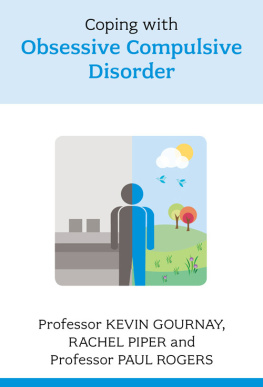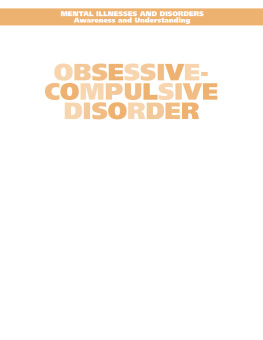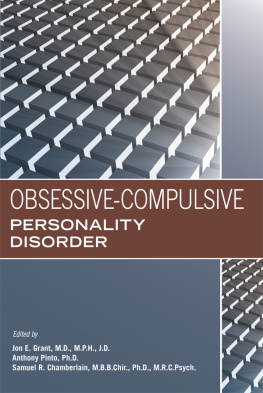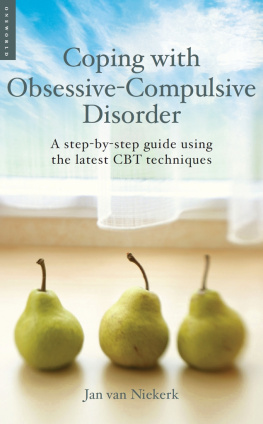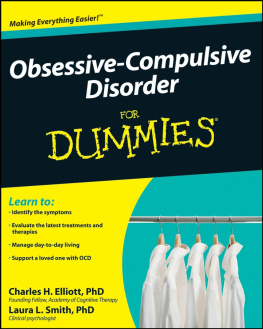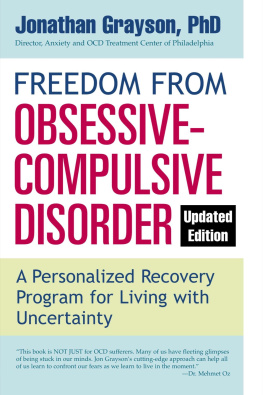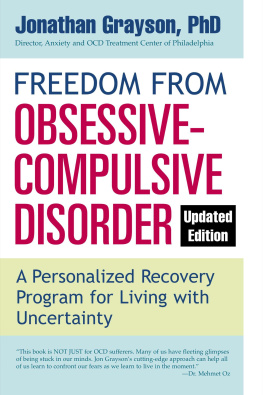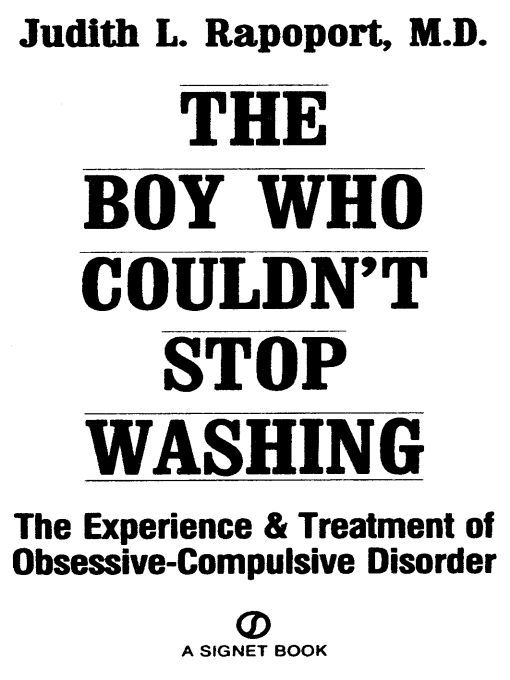Table of Contents
THIS BOOK, WITH ITS NEW INFORMATION AND LIVELY WRITING, AND INFORMED BY THE AUTHORS OBVIOUS COMPASSION FOR HER PATIENTS, MAKES AN IMPORTANT CONTRIBUTION TO UNDERSTANDING AN INTRIGUING AND IRRATIONAL ILLNESS.
The New York Times Book Review
An illuminating account of this prevalent mental health problem.
Washington Post
FASCINATING ... the author demonstrates not only great compassion, but humility and wide-ranging curiosity.
Psychiatric Times
EXCELLENT ... HIGHLY READABLE ... A CASEBOOK, SHOCKING REPORT AND SUPPORT TOOL ALL IN ONE.
Publishers Weekly
DR. JUDITH L. RAPOPORT is Chief of the Child Psychiatry Branch at the National Institute of Mental Health. A graduate of Swarthmore College and Harvard Medical School, she has been the recipient of the Outstanding Service Award from the U.S. Public Health Service and the Ittleson Prize in Child Psychiatry from the American Psychiatric Association. She lives with her family in Washington, D.C.
WELL WORTH READING ... CLEAR WRITING AND AN ABSORBING SUBJECT.
Los Angeles TimesBook Review
WILL BE IMMENSELY USEFUL TO PEOPLE WITH OBSESSIVE-COMPULSIVE DISORDER ... PARTICULARLY THOSE WHO SUFFER IN SECRET, UNAWARE OF WHAT TREATMENTS ARE AVAILABLE ... RAPOPORT PERFORMS A SERVICE BY PUBLICIZING HER PIONEERING WORK WITH A CRIPPLING AND, IN PART THANKS TO HER OWN RESEARCH, OFTEN TREATABLE MENTAL DISORDER.
Providence Journal
ADVANCES ARE EXPLAINED TO ENLIGHTEN ... NOT TO CONFUSE ... TO RECOGNIZE WHEN A SITUATION HAS GONE TOO FAR IS THE GOAL OF THIS BOOK, AND ONE RAPOPORT HAS ACHIEVED.
Arizona Daily Star
INTRIGUING ... CHOCK-FULL OF CASE STUDIES AND COMPLETE WITH POINTERS ON DIAGNOSIS ... KNOWLEDGEABLE, SYMPATHETIC GUIDE IN AN UNUSUAL FIELD.
KirkusReviews
THE DEDICATION AND CARE ... THE DELICACY AND SYMPATHY WITH WHICH SHE HAS ENTERED [THE PATIENTS] LIVES ... GIVE HER BOOK AN AUTHORITY AND A PERSONAL FEELING WHICH IS DEEPLY MOVING AND IMPRESSIVE.
OliverSacks, M.D.
RECOMMENDED ... THE INTERESTING TEXT IS FREE OF TECHNICAL JARGON.
Booklist
To Nancy and Margot
ACKNOWLEDGMENTS
Thanks are due to many friends, teachers, and associates past and present who encouraged my writing this book.
Susan Swedo, Henrietta Leonard, and Marge Coffey, all from the professional staff of the Child Psychiatry Branch, National Institute of Mental Health, were of enormous help in sifting through and discussing much of this material. Drs. Henry Gleitman, Michael Krause, Steven Wise, and Wallace Mendelson discussed the ideas and presentation at length. Dr. Alan Hobson generously gave me the notes on his famous case of Sebastian. Numerous other friends and colleagues also listened to ideas-in-formation, particularly Frank Sieverts, Arnold Friedhoff, John Sabini, Alan Fiske, Daniel Dennett, Dennis Murphy, Erica Goldberger, David and Louisa Schwartz, George Valliant, Mort Mishkin, and Everett Dulit. My sister, Leda, provided the very first encouragement for starting off at all, while my husband, Stanley, and sons Erik and Stuart all listened patiently and tolerantly for more hours than they should have had to, concerning the contents and progress of this book.
The administration of the NIMH: Fred Goodwin, Hazel Rea, Sue Thompson, and Ted Colburn, were encouraging in regard to the presentation of this clinical research material in an accessible form. Indirectly, the opportunity to work as a research scientist at the National Institutes of Health provided the research background that nurtured my fascination with this illness.
But most of all, thanks are due to all the patients who told me their stories and encouraged me to share their experience with others.
In addition my editors, Richard Marek and Jerry Gross, who put up with and greatly improved upon earlier drafts, deserve my greatest thanks.
This book represents a personal view, controversial and often premature. I hope other specialists in my own and related fields will forgive my trespass.
INTRODUCTION
Compulsive and obsessive have become everyday words. Im compulsive is how my friends describe their need for neatness, balanced checkbooks, punctuality, and shoes lined up in closets. Hes so compulsive is shorthand for calling someone uptight, controlling, and not much fun. Shes obsessed with him is a way of saying your friend is hopelessly love-sick. That is not how these words are used to describe Obsessive-Compulsive Disorder (OCD), a strange and fascinating sickness of ritual and doubts run wild. OCD can begin suddenly and is usually seen as a problem as soon as it starts. I have been learning about, and treating, this remarkable illness since 1972.
When the thoughts and rituals of OCD are intense, the victims work and home life disintegrate. With severe compulsions, endless rituals dominate each day. The most crippling obsessions create absurd, embarrassing, or frightening thoughts that repeat in the mind in an endless loop. OCD is a serious disease, and much more common than we ever thought. More than four million people in the United States suffer from its disabling thoughts or rituals. Amazingly, most OCDSUFFERERS keep their afflictions hidden.
Obsessive-Compulsive Disorder is also different from the superstitions of everyday life. Many people believe in lucky numbers, avoid walking under ladders, keep umbrellas closed in the house, or knock wood. My patients rituals go far beyond these common beliefs and habits, and seem a different problem altogether. In fact, as a group, my patients are not particularly superstitious. Everyday habits are somewhat useful and we can change them when we want. But obsessive-compulsive patients have rituals or thoughts they know are senseless, and waste hours every day using up precious school, work, or personal time. Although they have never met each other, my patients could be reading the same weird script.
I am a physician, a child psychiatrist, and a research scientist at the National Institute of Mental Health in Bethesda, Maryland. Of all of the many psychiatric studies I have carried out since 1962, and of the many unusual cases I have treated, none compare to the fascination and drama of OCD.
Senseless thoughts recur over and over again in the mind, appearing out of the blue; certain magical acts are repeated over and over again. For some the thoughts are meaningless (numbers, one number, or several), for others they are highly charged ideasfor example, I have just killed someone. The intrusion into conscious everyday thinking of such intense, repetitive, and (to the victim) disgusting, absurd, and alien thoughts is a dramatic and remarkable experience. You cant put them out of your mindthat is the nature of obsessions.
Some patients are checkers, they check lights, doors, locksten, twenty, or one hundred timesor repeat peculiar acts over and over again. Others spend hours producing unimportant symmetry. Shoelaces must be exactly even, eyebrows identical to a hair. But most often, the patient is a washer who feels he must wash over and over again. All of these problems have common themes: you cant trust your ordinary good judgment, cant trust your eyes that see no dirt, or really believe that the door is locked. You know you have done nothing harmful, but in spite of this good sense, you must go on checking and counting.


